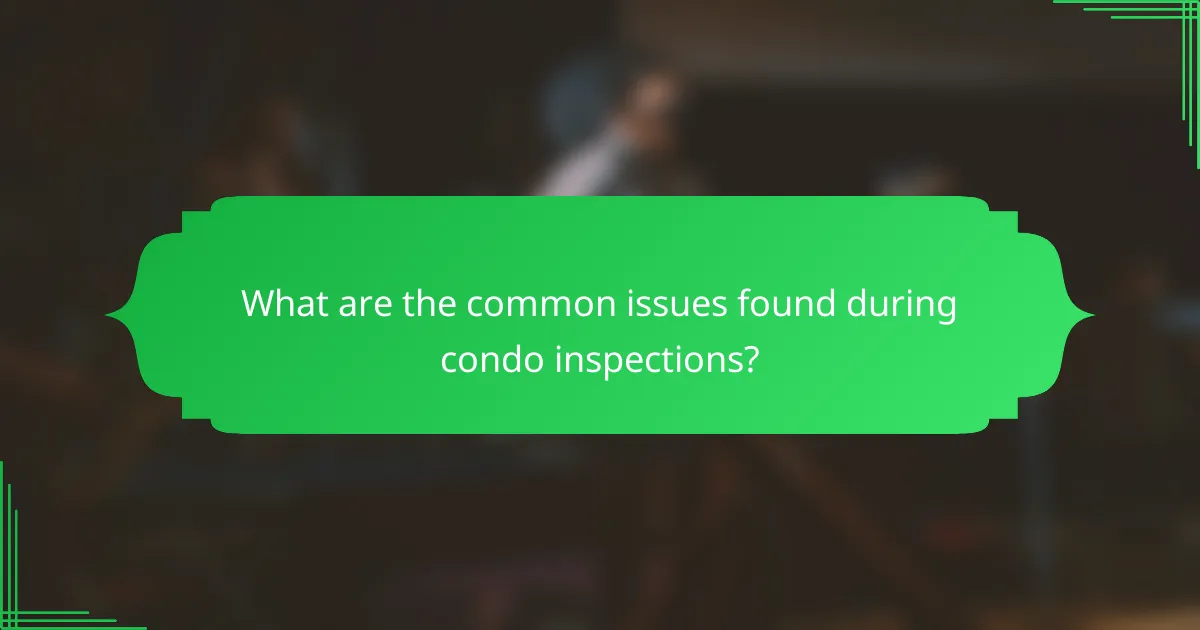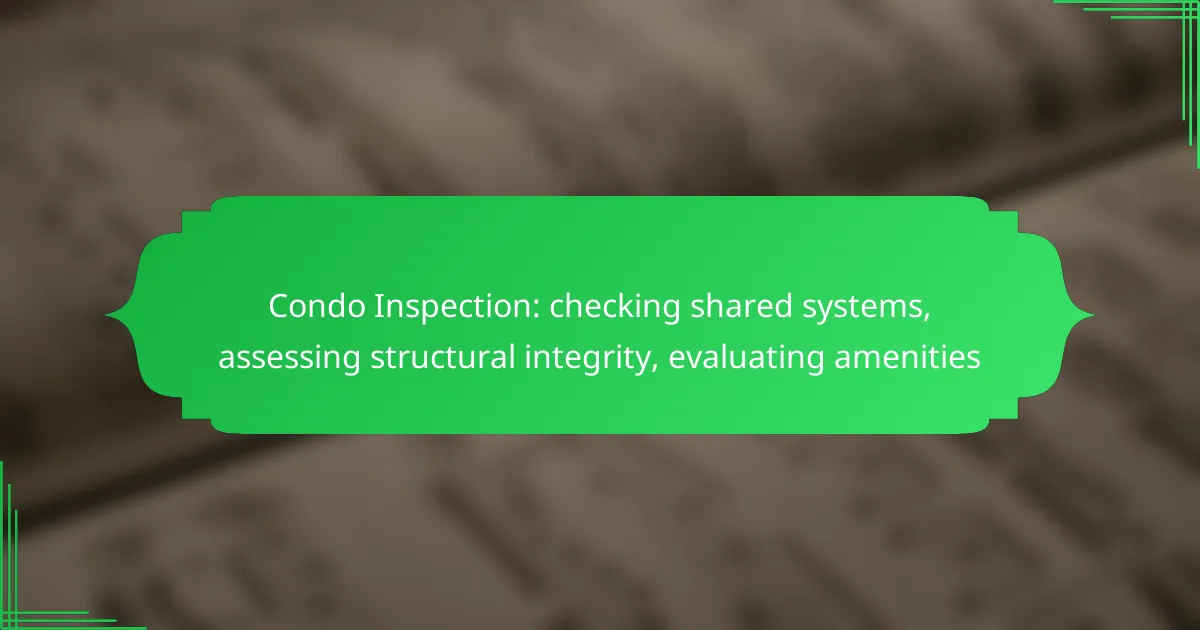A condo inspection is essential for evaluating shared systems, assessing structural integrity, and inspecting amenities to ensure the property is safe and functional. By focusing on key components like HVAC, plumbing, and electrical systems, the inspection helps identify potential issues that could affect comfort and safety. Additionally, assessing the building’s framework and common areas ensures compliance with safety standards, providing peace of mind for potential buyers or current owners.

What are the key components of a condo inspection?
A condo inspection focuses on evaluating shared systems, assessing structural integrity, and inspecting amenities. These components ensure that the property is safe, functional, and meets the expectations of potential buyers or current owners.
Shared systems evaluation
The shared systems evaluation examines essential communal features such as plumbing, electrical systems, heating, and cooling. Inspectors assess the condition and functionality of these systems, which can significantly impact living conditions and maintenance costs.
During this evaluation, it’s crucial to check for any signs of wear, leaks, or outdated components. For instance, a common pitfall is overlooking the age of the HVAC system, which may require replacement if it’s nearing the end of its lifespan.
Structural integrity assessment
The structural integrity assessment focuses on the building’s foundation, walls, and roof. Inspectors look for cracks, water damage, and signs of settling that could indicate serious issues.
It’s important to consider local building codes and standards during this assessment. For example, in areas prone to earthquakes, additional checks for seismic safety may be necessary. A thorough inspection can prevent costly repairs down the line.
Amenities inspection
The amenities inspection reviews shared facilities such as pools, gyms, and recreational areas. Inspectors evaluate the condition and safety of these amenities, which contribute to the overall value and appeal of the condo.
When inspecting amenities, consider factors like maintenance history and user accessibility. For instance, a well-maintained pool with regular cleaning schedules is more desirable than one that appears neglected. Ensuring that amenities meet safety standards is also essential for resident satisfaction.

How to assess shared systems in a condo?
To assess shared systems in a condo, focus on the key components that impact comfort and safety, including HVAC, plumbing, and electrical systems. A thorough inspection can identify potential issues and help ensure that these systems meet necessary standards and function efficiently.
HVAC system checks
When inspecting the HVAC system, look for signs of wear and tear, such as rust on components or unusual noises during operation. Check the age of the system; units over 10-15 years old may require replacement or significant repairs.
Ensure that the air filters are clean and that the ducts are free from blockages. Regular maintenance records can provide insight into how well the system has been cared for, which is crucial for long-term performance.
Plumbing system evaluation
Assess the plumbing system by checking for leaks, water pressure, and the condition of pipes. Look for visible signs of water damage or mold, which can indicate underlying issues. Older condos may have galvanized pipes that are prone to corrosion, so consider the material and age of the plumbing.
Test faucets and toilets for functionality and inspect the water heater for age and efficiency. A typical lifespan for water heaters is around 8-12 years, so factor this into your evaluation.
Electrical system inspection
Inspect the electrical system by checking the circuit breaker panel for any signs of overheating or tripped breakers. Ensure that all outlets are functional and that there are no exposed wires or outdated wiring, which can pose safety hazards.
Consider the overall capacity of the electrical system, especially in older buildings where upgrades may be necessary to accommodate modern appliances. A qualified electrician can provide a detailed assessment if you suspect any issues.

What should be included in a structural integrity assessment?
A structural integrity assessment evaluates the soundness of a building’s framework, ensuring it can safely support its intended loads. Key elements include examining the foundation, inspecting walls and roofs, and checking common areas for safety compliance.
Foundation examination
The foundation is critical for the stability of a condo. Inspectors should look for signs of settling, cracking, or water damage, which can indicate structural issues. It’s essential to assess whether the foundation is level and properly anchored to prevent future problems.
Common methods for foundation examination include visual inspections and using tools like laser levels or moisture meters. If significant issues are found, consulting a structural engineer may be necessary to determine the extent of repairs needed.
Wall and roof inspection
Inspecting walls and roofs involves checking for cracks, leaks, and signs of deterioration. Walls should be examined for bowing or bulging, while roofs need to be assessed for missing shingles or water pooling. Both conditions can lead to serious structural damage if not addressed promptly.
Inspectors should also evaluate insulation and ventilation in these areas, as poor conditions can affect energy efficiency and lead to moisture problems. Regular maintenance, such as cleaning gutters and sealing cracks, can help prevent larger issues.
Common area safety checks
Common areas, such as hallways, stairwells, and recreational facilities, must meet safety standards to ensure resident well-being. Inspectors should check for adequate lighting, handrails, and clear pathways to prevent accidents. Additionally, fire safety measures, including alarms and extinguishers, should be in working order.
Regular safety audits can help identify potential hazards in shared spaces. Residents should be encouraged to report any concerns, as maintaining these areas is crucial for overall safety and compliance with local regulations.

How to evaluate condo amenities effectively?
To evaluate condo amenities effectively, focus on their condition, accessibility, and how well they meet your lifestyle needs. Consider factors such as maintenance, safety, and the overall experience they provide to residents.
Fitness center condition
Assess the fitness center by checking the quality and variety of equipment available. Look for well-maintained machines, free weights, and space for activities like yoga or group classes. Ensure that the area is clean and well-lit, as this contributes to a positive workout environment.
Also, inquire about the hours of operation and whether the fitness center is accessible to all residents. Some condos may have restrictions or require a key fob for entry, which can affect your ability to use the facilities when needed.
Pool and recreational areas
Examine the pool and recreational areas for cleanliness and safety features. Check for proper maintenance, including clear water, functioning filtration systems, and well-kept surrounding spaces. Look for amenities like lounge chairs, umbrellas, and BBQ grills that enhance the recreational experience.
Consider the pool’s accessibility and operating hours. Some condos may have seasonal pools or specific hours for adult swim, which can impact your enjoyment. Additionally, verify if there are any rules regarding guest access to these areas.
Security features
Evaluate the security features of the condo, including entry systems, surveillance cameras, and on-site personnel. A secure building often has controlled access points, such as key fob entry or intercom systems, which help protect residents.
Check for additional safety measures like well-lit parking areas and emergency exits. Understanding the security protocols in place can provide peace of mind and enhance your overall living experience in the condo community.

What are the common issues found during condo inspections?
Common issues during condo inspections include water damage, electrical code violations, and structural cracks. Identifying these problems early can help prevent costly repairs and ensure the safety and comfort of residents.
Water damage signs
Water damage is a frequent concern in condos, often indicated by stains, mold, or peeling paint. Inspectors typically check for signs of leaks around windows, ceilings, and plumbing fixtures.
To assess potential water damage, look for discoloration on walls and ceilings, musty odors, and warped flooring. If any of these signs are present, further investigation is warranted to determine the source and extent of the damage.
Electrical code violations
Electrical code violations can pose serious safety risks in condos. Common issues include outdated wiring, overloaded circuits, and improper grounding. These violations can lead to electrical fires or system failures.
During an inspection, ensure that all outlets are grounded and that circuit breakers are appropriately rated for the load they carry. If the condo has older wiring, consider upgrading to meet current safety standards.
Structural cracks
Structural cracks can indicate significant underlying issues in a condo’s foundation or walls. Inspectors look for cracks wider than a few millimeters, particularly those that are horizontal or stair-step in nature.
When assessing structural cracks, consider their location and direction. Cracks in load-bearing walls or near windows and doors may require immediate attention from a structural engineer to evaluate the integrity of the building.

What criteria should be used for selecting a condo inspector?
When selecting a condo inspector, prioritize their experience, qualifications, and familiarity with shared systems and amenities. A qualified inspector should have a strong background in condo inspections and a thorough understanding of structural integrity assessments.
Experience and qualifications
Look for inspectors with several years of experience specifically in condo inspections. They should be well-versed in evaluating shared systems such as plumbing, electrical, and HVAC, as these can significantly impact the overall condition of the property.
Check for relevant certifications or licenses that demonstrate their expertise. In many regions, inspectors may need to meet specific state or local requirements, so ensure they comply with these regulations.
Ask for references or reviews from previous clients to gauge their reliability and thoroughness. A good inspector should be able to provide examples of past inspections and discuss any challenges they encountered and how they resolved them.
